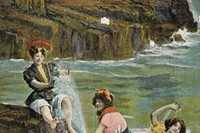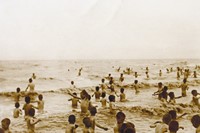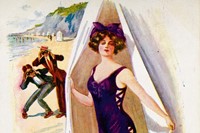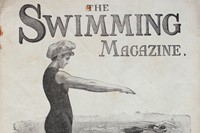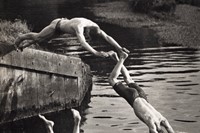Whether in lidos, lakes or oceans, outdoor swimming has long been enjoyed as a British pastime but recent decades have seen it increasingly neglected in favour of swimming in indoor...
Whether in lidos, lakes or oceans, outdoor swimming has long been enjoyed as a British pastime (think the annual tradition of Boxing Day dips); but recent decades have seen it increasingly neglected in favour of swimming in indoor, chlorinated pools, which allow for a regularised swim, unaffected by climate and compliant with our modern-day obsession with health and safety.
In the face of such adversity, a new book by author and outdoor swimming enthusiast Susie Parr, vividly revives the joys of "wild swimming" through a selection of wonderful images and an enlightening exploration into the social history of bathing in Britain – from the earliest allusions in Roman and Anglo Saxon literature right up until the decline of British seaside resorts in the twentieth century.
"Victorian women would enter the water in hats, coats and corsets, titillating male observers with a flash of the ankles..."
The Story of Swimming considers the sport and its changing roles chronologically, through the eyes of various generations and movements: the Elizabethans viewed sea-bathing as medicinally beneficial and set up refined watering places, like Scarborough, for that purpose; while the Romantic poets shunned any such elegance, seeking sublime inspiration in Nature’s fickle waters. Meanwhile, the Victorian age and the effects of the industrial revolution (which allowed for fast, easy travel) saw the explosion of the seaside holiday resort, where communal bathing was zealously embraced by adults and children alike. This was also the time when a prescribed scientific order was placed upon swimming, differentiating between strokes and assigning them formal (typically Victorian) associations.
The book also sheds interesting light on political aspects of swimming, such as the changing role of women in society as reflected by their bathing attire. Victorian women, for example, would enter the water in hats, coats and corsets, titillating male observers with a flash of the ankles; while the early 1900s saw the rise of streamlined swimwear allowing for a practical enjoyment of the sport. And by the time the 1930s arrived, women could be seen parading the beach in stylish, revealing bathing suits, pictured on postcards with accompanying slogans, like: "We do see 'side' at the seaside".
In its entirety, the volume acts as a beautifully woven collage – part journal, part history, scattered with poetry and prose extracts, photographs and illustrations – pieced together by one of bathing's most loyal devotees, whose dedication to her subject is entirely infectious: "I am more a bather than a swimmer. I love to dip, float, reflect and dream in true Romantic fashion...gazing at the landscape, twisting, turning and freely switching directions as I relish my buoyancy."
The Story of Swimming by Susie Parr is published by Dewi Lewis Media and is on sale now, retailing at £25.
Text by Daisy Woodward

